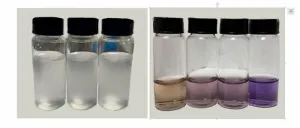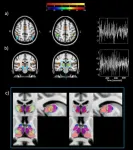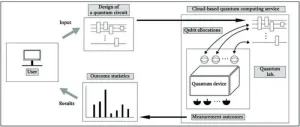(Press-News.org) Researchers at São Paulo State University (UNESP) in Brazil have developed a strategy for removing glyphosate, one of the world’s most frequently used herbicides, from water. Inspired by the concept of the circular economy, the technique is based on sugarcane bagasse, a waste material produced by sugar and ethanol plants.
“Isolated and chemically functionalized sugarcane bagasse fibers can be used as adsorbent material. Glyphosate adheres to its surface and is removed as a water contaminant by filtration, decantation or centrifugation,” Maria Vitória Guimarães Leal, told Agência FAPESP. She is the first author of an article on the research published in the journal Pure and Applied Chemistry. Adsorption is a process whereby molecules dispersed in a liquid or gaseous medium adhere to a solid insoluble surface, which is typically porous.
Owing to its low cost and high potential to raise crop yields, glyphosate is widely used to control the growth of unwanted plants, such as weeds, invasive species and agricultural pests, but scientific studies have shown that it can be a human health hazard and in particular may pose a cancer risk. Application of glyphosate-containing products is restricted or banned in Austria, Bulgaria, Colombia, Costa Rica, Denmark, El Salvador, Germany and Greece, among other countries. In Brazil, however, annual use of such products averages 173,150.75 metric tons. Part of them is borne away by rain into rivers, wells and other aquatic environments.
With FAPESP’s support via three projects (14/50869-6, 20/06577-1 and 21/09773-9), scientists at UNESP’s School of Sciences and Technology (FCT) in Presidente Prudente found a way to remove glyphosate products from water in research led by postdoctoral fellow Guilherme Dognani and Aldo Eloizo Job, a professor at FCT-UNESP.
How it works
Dognani explained the procedure. “The bagasse is shredded and the cellulose isolated by separating it from the hemicellulose and lignin. The cellulose fibers are then functionalized by adding quaternary ammonia groups to their surface so that the material is positively charged. The resulting cationic cellulose microfibers bind easily to glyphosate,” he said.
Leal added that there are certain favorable conditions, such as pH variation, which was the focus of the study. “When pH is varied, both the adsorbent material and the glyphosate display different molecular configurations. The most efficient level for interaction between them, inducing the most adsorption and hence optimal removal, is pH 14,” he said.
To evaluate adsorption capacity, the researchers prepared fractions of a glyphosate solution with pH 2, 6, 10 and 14, measured using a pH meter. They then added to each fraction identical amounts of functionalized cellulose microfiber. The flasks with the solution contaminated by glyphosate plus cellulose were agitated for 24 hours. In accordance with the procedure described in the literature, they were then heated in a water bath until the reaction occurred, cooled to room temperature and analyzed by visible light spectrophotometry. Removal efficiency was calculated as a ratio of initial to final glyphosate levels in each sample, and adsorption capacity was calculated as a function of pH.
About São Paulo Research Foundation (FAPESP)
The São Paulo Research Foundation (FAPESP) is a public institution with the mission of supporting scientific research in all fields of knowledge by awarding scholarships, fellowships and grants to investigators linked with higher education and research institutions in the State of São Paulo, Brazil. FAPESP is aware that the very best research can only be done by working with the best researchers internationally. Therefore, it has established partnerships with funding agencies, higher education, private companies, and research organizations in other countries known for the quality of their research and has been encouraging scientists funded by its grants to further develop their international collaboration. You can learn more about FAPESP at www.fapesp.br/en and visit FAPESP news agency at www.agencia.fapesp.br/en to keep updated with the latest scientific breakthroughs FAPESP helps achieve through its many programs, awards and research centers. You may also subscribe to FAPESP news agency at http://agencia.fapesp.br/subscribe.
END
Brazilian researchers develop method of purifying water contaminated by glyphosate
The technique uses functionalized cellulose fibers from sugarcane bagasse to remove residues of the herbicide from an aqueous medium
2023-09-22
ELSE PRESS RELEASES FROM THIS DATE:
Vizient awards UCSF Health top marks for quality patient care
2023-09-22
Hospital quality ratings assess safety, equity and effectiveness in hospitals nationwide
Vizient Inc. has named UCSF Health as a Top Performer for its high-quality patient care in the 2023 Bernard A. Birnbaum, MD, Quality Leadership Ranking.
This is the second year in a row that Vizient has recognized UCSF Health as a leader in health care quality. This year, UCSF Health ranked seventh among comprehensive academic medical centers, out of 116 medical centers that were evaluated in that cohort and ...
New research adds evidence to the benefits of ginger supplements for treating autoimmune diseases
2023-09-22
New research has revealed a potentially important role ginger supplements can play in controlling inflammation for people living with autoimmune diseases.
The research published today in JCI Insight focused on studying the impact of ginger supplementation on a type of white blood cell called the neutrophil. The study was especially interested in neutrophil extracellular trap (NET) formation, also known as NETosis, and what it may mean for controlling inflammation.
The study found ginger consumption by healthy individuals makes their neutrophils more resistant to NETosis. This is important because NETs are microscopic spider web-like structures that propel inflammation and clotting, which ...
The role of the locus coeruleus. A blue stain linked to sleep
2023-09-22
A study conducted by researchers at the University of Liège (BE) Institute, using ultra-high field 7 Tesla MRI, are providing a better understanding of how sleep is regulated.
We've known for a long time that sleep is good for the brain. We also know that light is not just for seeing, but also plays an important role in other aspects such as mood. What we don't know is how all this happens in our brains. Two separate studies, carried out by researchers at the University of Liège using the 7 Tesla MRI on the GIGA-Centre de Recherche du Cyclotron platform, offer the ...
NASA’s Webb finds carbon source on surface of Jupiter’s moon Europa
2023-09-22
Jupiter’s moon Europa is one of a handful of worlds in our solar system that could potentially harbor conditions suitable for life. Previous research has shown that beneath its water-ice crust lies a salty ocean of liquid water with a rocky seafloor. However, planetary scientists had not confirmed if that ocean contained the chemicals needed for life, particularly carbon.
Astronomers using data from NASA’s James Webb Space Telescope have identified carbon dioxide in a specific region on the icy surface of Europa. Analysis indicates that this carbon likely originated in the subsurface ocean and ...
Wildlife mitigating measures no help for Ottawa’s freshwater turtles
2023-09-22
Local turtles facing extinction within a decade due to urban growth, says uOttawa study.
Urban sprawl and insufficient relief measures have left an Ottawa-area freshwater turtle facing extinction within the decade, says new research from the University of Ottawa and Trent University, which tracked changes to the turtle’s habitat over a 10-year period.
Specifically, the development of Terry Fox Drive in the city’s west end has led to a dangerous decline in the Blanding’s turtle’s (Emydoidea blandingii) habitat, leading to a 70% decline in adult population size, despite mitigating measures such as wildlife fencing, new wetlands ...
A network that spreads light and the role of thalamus in our brain
2023-09-22
New research conducted at the University of Liège, using ultra-high field 7 Tesla MRI, provides a better understanding of how light stimulates our brain and could provide new insights into how it works.
A research team at the ULiège GIGA Institute tried to understand better how light stimulates our cognition. Light acts like a cup of coffee and helps keep us awake. That's why we recommend not using too much light on our smartphones and tablets in the evening. This can disrupt our sleep. On the other hand, the same light can help us during the day. Many studies have shown that good lighting can help students in schools, ...
Unraveling the mysteries of glassy liquids
2023-09-22
Glass, despite its apparent transparency and rigidity, is a complex and intriguing material. When a liquid is cooled to form a glass, its dynamics slows down significantly, resulting in its unique properties.
This process, known as “glass transition”, has puzzled scientists for decades. But one of its intriguing aspects is the emergence of "dynamical heterogeneities," where the dynamics become increasingly correlated and intermittent as the liquid cools down and approaches the glass transition temperature.
In a new study, researchers propose a new theoretical framework to explain these dynamical heterogeneities in glass-forming ...
Can cloud-based quantum computing really offer a quantum advantage?
2023-09-22
A quantum machine can drastically speed up certain kinds of computation, but only if two or more quantum bits in the machine are entangled---that is, capable of displaying related behavior despite being separated. Seeking a way for users of cloud-based quantum computing services to detect qubit entanglement, Jiheon Seong and Joonwoo Bae of the Korea Advanced Institute of science and Technology developed and tested an entanglement witness circuit. It works to certify entanglement even when the cloud-based service allows only limited control ...
UNC-Chapel Hill research presents new development model for the world's third-longest river
2023-09-22
A new research paper published in Science Advances reveals how changes in the size of the Yangtze River watershed may have led to the carving of deep canyons.
In this study, UNC-Chapel Hill professor Eric Kirby and his co-authors explore the impact of drainage basin expansion on the growth of the Yangtze River.
“This study presents a new model for when and how the Yangtze River was born,” said Kirby, “The Yangtze is one of the world’s great rivers, rising on the Tibetan Plateau at altitudes over 17,000 feet and descending ...
Why are you better at recognizing upright faces? Clues from a person who sees the world differently
2023-09-22
When you see a familiar face upright, you’ll recognize it right away. But if you saw that same face upside down, it’s much harder to place. Now researchers who’ve studied Claudio, a 42-year-old man whose head is rotated back almost 180 degrees such that it sits between his shoulder blades, suggest that the reason people are so good at processing upright faces has arisen through a combination of evolution and experience. The findings appear September 22 in the journal iScience.
“Nearly everyone has far more experience with upright faces and ancestors whose reproduction ...
LAST 30 PRESS RELEASES:
Study uncovers disrupted brain balance in alcohol dependence
Working in groups can help Republicans and Democrats agree on controversial content moderation online
Structural findings reveal how distinct GPCR ligands create different levels of activation
Anything-goes “anyons” may be at the root of surprising quantum experiments
UC review: Maximizing workplace opportunity for veterans
From generation to complex control: Metasurfaces make perfect vortex beams "within reach"
Thin-film lithium niobate-based detector: recent advances and perspectives
Exploring why some people may tend to persistently make bad choices
How cells balance their protein levels
Nirsevimab vs RSVpreF vaccine for RSV–related hospitalization in newborns
Effectiveness and impact of maternal RSV immunization and nirsevimab on medically attended RSV in US children
AI gives scientists a boost, but at the cost of too many mediocre papers
Next-generation vision model maps tree growth at sub-meter precision
Genes aren’t destiny for inherited blindness, study shows
MIT study: High-fat diets make liver cells more likely to become cancerous
Exposure to multiple fine particulate matter components and incident depression in the US Medicare population
Risk of burdensome health care spending over time in the US
Nirsevimab against hospitalizations and emergency department visits for lower respiratory tract infection in infants
New microfluidics technology enables highly uniform DNA condensate formation
A new strategy for immune tolerance
Super Mario Bros. help fight burnout: New study links classic games to boosted happiness
Deepest gas hydrate cold seep ever discovered in the arctic: International research team unveils Freya Hydrate Mounds at 3,640 m depth.
Integrating light and structure: Smarter mapping for fragile wetland ecosystems
ACA-SIM: A robust way to decode satellite signals over complex waters
Probiotics can restore gut microbiome in breastfed infants
AI could help predict nutrition risks in ICU patients, study finds
Federal EITC has unexpected result, researchers say – it decreases domestic violence
Researchers identify gene that calms the mind and improves attention in mice
Artificial metabolism turns waste CO2 into useful chemicals
Ancient sea anemone sheds light on animal cell type evolution
[Press-News.org] Brazilian researchers develop method of purifying water contaminated by glyphosateThe technique uses functionalized cellulose fibers from sugarcane bagasse to remove residues of the herbicide from an aqueous medium









